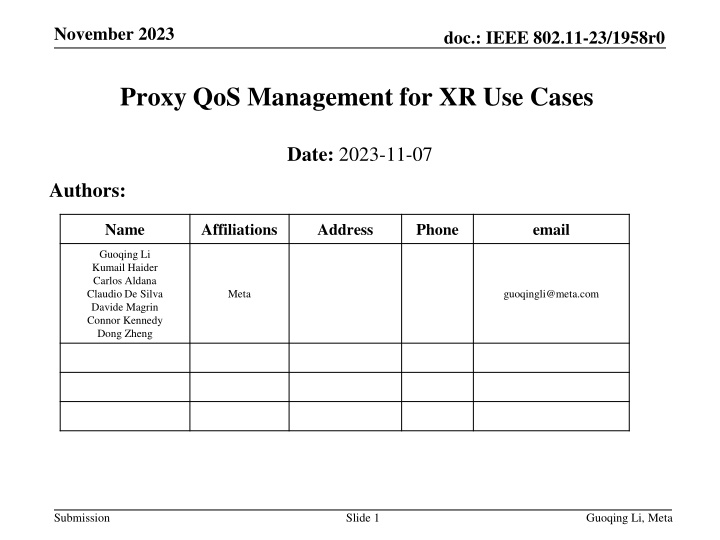Proxy QoS Management for XR Devices in IEEE 802.11-23/1958r0 - November 2023
This document discusses the challenges faced by XR devices in terms of size, thermal constraints, cost, and power limitations leading to the proposal of Proxy QoS Management to enhance Wi-Fi performance. The aim is to leverage TGbn devices for improving legacy devices' connectivity within a Wi-Fi network. The proposal includes mechanisms for signaling and QoS management between TGbn devices and legacy devices, aiming to optimize AP scheduling and enhance the overall XR user experience.
Uploaded on Nov 27, 2024 | 1 Views
Download Presentation

Please find below an Image/Link to download the presentation.
The content on the website is provided AS IS for your information and personal use only. It may not be sold, licensed, or shared on other websites without obtaining consent from the author.If you encounter any issues during the download, it is possible that the publisher has removed the file from their server.
You are allowed to download the files provided on this website for personal or commercial use, subject to the condition that they are used lawfully. All files are the property of their respective owners.
The content on the website is provided AS IS for your information and personal use only. It may not be sold, licensed, or shared on other websites without obtaining consent from the author.
E N D
Presentation Transcript
November 2023 doc.: IEEE 802.11-23/1958r0 Proxy QoS Management for XR Use Cases Date: 2023-11-07 Authors: Name Affiliations Address Phone email Guoqing Li Kumail Haider Carlos Aldana Claudio De Silva Davide Magrin Connor Kennedy Dong Zheng Meta guoqingli@meta.com Submission Slide 1 Guoqing Li, Meta
doc.: IEEE 802.11-23/1958r0 November 2023 Introduction and Problem Statement Due to size, thermal, cost and power constraint, XR devices may leverage a different device for computation This is termed Remote Rendering, see the figure below As data is exchanged between the remote computer device and XR device through AP, both Wi- Fi links have great impact on the overall XR user experience However, the compute device may not have the latest Wi-Fi technology and cannot exercise advanced Wi-Fi features For example, AP lacks necessary info to optimize its OFDMA scheduling for the remote device and the Wi-Fi performance at the remote device may not be satisfactory This problems is also explained in Doc #23/1885 Therefore, we need a mechanism to improve a legacy device s WiFi performance via TGbn device AP (TGbn capable) Remote computer device (TGbn capable) Remote computer device (e.g., Wi-Fi 6) Submission Slide 2 Guoqing Li, Meta
doc.: IEEE 802.11-23/1958r0 November 2023 Proposal: Proxy QoS Management We propose to define mechanism(s) to allow a TGbn device to help improve the Wi-Fi performance of a legacy device in the same Wi- Fi network Signaling should be defined between TGbn STA and TGbn AP, but the signaling info can be applied to remote legacy device s Wi- Fi link with the AP AP (TGbn capable) Remote computer device (TGbn capable) Remote computer device (a legacy device) Submission Slide 3 Guoqing Li, Meta
doc.: IEEE 802.11-23/1958r0 November 2023 Proposal: More Details Allows SCS to carry QoS IE on behalf of another device Proxy SCS SCS Request or SCS Descriptor or QoS IE may be modified to include another device s QoS info The info carried in P-SCS may be used to improve AP s scheduling for the remote legacy device P-SCS AP (TGbn capable) Remote computer device (TGbn capable) Remote computer device (a legacy device) Submission Slide 4 Guoqing Li, Meta
doc.: IEEE 802.11-23/1958r0 November 2023 Discussion Device ID MAC address is needed for AP s UL OFDMA scheduling algorithm and should be included in P-SCS Obtaining legacy device s MAC address is out of the scope of TGbn and can be done through application level message exchange For traffic classification based prioritization, TCLASS may be used by XR device for AP to classify downlink traffic to another legacy devices Submission Slide 5 Guoqing Li, Meta
doc.: IEEE 802.11-23/1958r0 November 2023 Summary Remote Rendering XR use cases require Wi-Fi optimization for both TGbn device as well as legacy devices We propose to define a mechanism in TGbn to allow a TGbn device to provide QoS related information to AP in order to optimize a legacy device s performance in the local network Submission Slide 6 Guoqing Li, Meta























